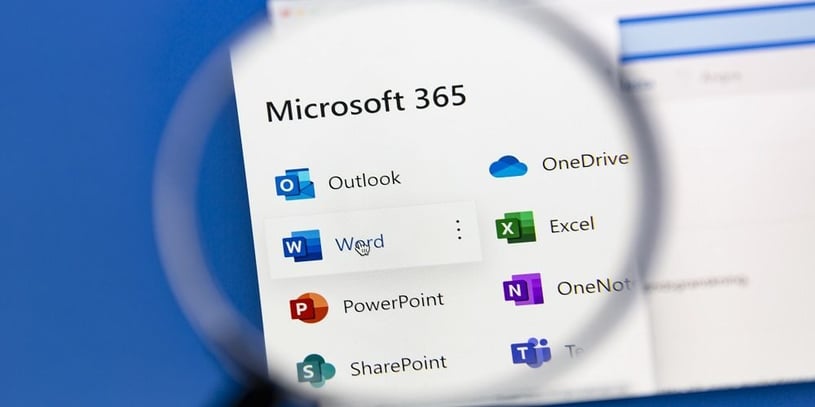An overview of M365 data recovery: the capabilities, cost, licensing, pros, cons and things to consider when determining if standalone is a fit for your organization.

Magnified cursor over Microsoft 365 apps. Image courtesy of Adobe Stock.
When managing records, mere retention is not enough. Organizations should ensure that the tools they use provide sufficient data recovery capabilities in case of accidental deletion, file corruption or other data loss.
Regarding Microsoft 365 (M365), formerly Office 365, we are asking: does M365 standalone provide the content backup and data recovery features your organization requires to avoid these risks?
We'll cut right to the chase: the answer is maybe.
Native Microsoft 365 has a powerful tool set offering two data recovery options that we will break down in the following section, including how licensing and costs apply.
However, determining whether these are suitable for your organization’s specific data recovery needs will require you to answer a few questions. We’ve listed these below as well.
Altogether, this article covers:
- An overview of native Microsoft 365 data recovery tools
- Upsides of these features
- Things to consider
- 6 questions to determine whether M365 native data recovery is right for your organization
We’ve also written articles covering Microsoft 365 records management compliance capabilities and answering frequently asked questions about managing physical records in Microsoft 365.
What native data recovery tools does Microsoft 365 offer?
There are two data recovery options available through Microsoft 365: standard and via compliance retention.
Standard
Data can be recovered with retention policies. The standard M365 native data recovery allows organizations to restore data within a period of 93 days.
How does this work?
Users can enable retention policies for the majority of Microsoft 365 applications and their data types, including Exchange Online, Teams, SharePoint and OneDrive. Once retention policies are on, they ensure data remains in Microsoft 365 for the designated amount of time. In case of accidental data deletion, these retention policies will remove deleted content from other M365 applications, but keep the items accessible and searchable using Compliance eDiscovery and within the Preservation library for 93 days.
Compliance Retention
Organizations that require post-deletion recovery options for longer than 93 days can use M365 Compliance Center retention policies for unlimited retention and data recovery periods. This allows organizations to preserve deleted or modified data as long as is needed.
However, this is only available for top tier E3/E5 licenses (costs and availability discussed below in Things to Consider) and lacks automatic recovery features (meaning it requires manual configuration).
The pros of using Microsoft 365 data recovery
Organizations already using Microsoft 365 E3 and E5 can benefit from enabling the Compliance Center data recovery capabilities. With continuous data retention and recovery, and tight integration with other M365 management tools, organizations will get more value out of a tool they are already paying for.
Things to consider with Microsoft 365 data recovery
Most organizations need to save files for longer than 93 days to fulfill their recovery policy, so they would have to go with the top level M365 licenses to access the Microsoft Compliance Center capabilities. However, surveys have found that only about 4% of organizations use Microsoft Compliance Center retention policies for data recovery. Why the low adoption rate?
This tier of capabilities comes with three potential setbacks:
1. Limited Availability
Compliance Center features are only available in the most senior E3 and E5 Microsoft 365 plans. Even organizations who have E3 and/or E5 licenses may not have them for all users, so they end up mixing multiple subscriptions by purchasing standard business plans for their non-executive and frontline staff. This limits who can have unlimited data recovery periods.
2. Upgrading Costs
To upgrade from a Microsoft 365 business subscription (which costs between $12.5-$22 USD) to E3 (which is currently set at $36 USD) requires at least a $14 increase per user, per month. The jump from a $22 USD Business Premium account to E5 (currently priced at $57 USD) would be an increase of $35 per user per month.
Depending on how many users need to be upgraded, this would get costly very quickly.
3. Additional Configuration Required
Enabling retention policies for the users with E3/E5 licenses also takes manual configuration, requiring support from organizational IT, Microsoft or third party service providers (which we are happy to help you out with!).
6 questions to determine whether M365 native data recovery is right for your organization
If you are using or considering Microsoft 365 and would like to know whether the either of these data recovery options are a fit, it’s worth asking the following questions:
1. What is your organization’s industry? What are your data retention requirements?
Will the standard M365 native data recovery period of 93 days be enough? Or would you require a longer period, available only through the M365 Compliance Center?
2. Are you already using M365 data protection features, or those of a third-party vendor? If not, do you have a data protection plan?
Having a data protection plan in place is critical to avoid getting into hot water (such as fines or lawsuits) is case of organizational data loss or tampering.
3. Which M365 license does your organization use? How many and what type of users does your organization consist of?
Does your organization already use E3/E5 (or G3/G5 if you are government), and can benefit from the Compliance Center without upgrading? Are you mixing multiple plans, or using other plans and require a license upgrade? How many users will require this upgrade?
4. What is your organizational budget?
Depending on your answer to question #3, does your organization have the budget required to make the license upgrade for your users who are not yet on E3 or E5?
5. Do you have content stored in repositories outside of Microsoft 365, such as file shares, physical records or other applications?
Keep in mind that unless you are using the Microsoft 365 connectors or those from a third-party integration tool such as Collabspace, these data recovery capabilities will only apply to your Microsoft 365 content.
6. Do you have everything configured?
Additional configuration will be required. Does your IT and/or Records Management team have the workload capacity for necessary configuration and retention schedule planning? If not, do you have the budget for Microsoft or another knowledgeable Services Team to support?
Conclusion
Microsoft 365 is a go-to for many organizations’ content storage. It offers two options for retention and data recovery: standard and compliance. Standard offers up to 93 days of data recovery, while compliance has limitless retention and recovery but is only available for senior E3/E5 (or G3/G5) users.
As most organizations require 3+ years of records retention, all users would have to be on or upgrade to an E3/E5 plan. So knowing whether M365 standalone is suitable for your organization’s data recovery plan requires asking which licenses you have, what your budget is and if you have the resources necessary to configure what is needed.
Whether your research guides you to keep your Microsoft 365 as is OR to explore third-party options, we are happy to help. As a Microsoft Gold Partner, Collabware has a Services Team with expertise in Microsoft 365, information governance and data protection who is ready to help you make the most of your Microsoft investment, or find an option that best suits your budget and company processes. To avoid upgrading, you can also bring on a third party tool, such as our cloud solution Collabspace, for unlimited users, versioning, auto-categorization, retention and WORM-compliance to avoid data loss, deletion or tampering.
Contact us with your questions. To learn more about Microsoft 365 records management capabilities, download our free capabilities comparison chart below:




.jpg)

